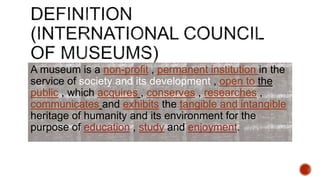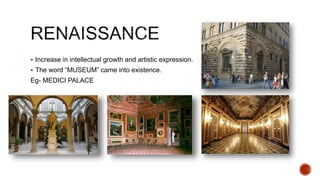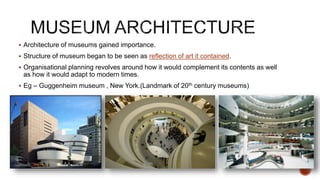Evolution of museums
- 1. 1
- 2. ï§ DEFINITION ï§ EVOLUTION 1.CLASSIC ANTIQUITY 2.MIDDLE AGES 3.RENAISSANCE 4.MODERN 5.MUSEUM ARCHITECTURE 6.GENERAL CLASSIFICATION IN MUSEUM ARCHITECTURE 7.MUSEUMS BASED ON CURIOSITIES OF GENERATIONS 8.PARTICIPATORY ACTIVITES 9.EASE OF INTERNET ï§ TYPOLOGY IN MUSEUMS
- 3. A museum is a non-profit , permanent institution in the service of society and its development , open to the public , which acquires , conserves , researches , communicates and exhibits the tangible and intangible heritage of humanity and its environment for the purpose of education , study and enjoyment.
- 4. 15TH CENTURY â Started with idea of preserving culture leading to COLLECTION OF IDEAS AND MEMORIES. Eg: CHITRASHALAS IN ANCIENT INDIA - Source of entertainment as well as means of education. - Old palace( Bundi palace), now museum @ New Delhi.
- 5. CHITRASHALA , BUNDI PALACE , RAJASTHAN
- 6. 1.1st organised museum- ALEXANDRIYA MUSEUM,EGYPT 2.Greece -âMOUSEIONâ meant temple, dedicated to muses.
- 7. 3.Rome - Open air museum.(Roman forums)
- 8. ï§ Growth of Christianity, so does the appreciation for art. ï§ Thus, churches and temples became platforms for public exhibit making them public museums. ï§ Eg-Basilica san vitale , Italy.
- 9. ï§ Increase in intellectual growth and artistic expression. ï§ The word âMUSEUMâ came into existence. Eg- MEDICI PALACE
- 10. ï§ European idea to make museums more public. ï§ After French revolution (1789), museums became truly public. ï§ Eg- Louvre Museum, Paris.- WORLDâS LARGEST MUSEUM.
- 11. ï§ Architecture of museums gained importance. ï§ Structure of museum began to be seen as reflection of art it contained. ï§ Organisational planning revolves around how it would complement its contents as well as how it would adapt to modern times. ï§ Eg â Guggenheim museum , New York.(Landmark of 20th century museums)
- 12. 1. Purposely built Eg-Metropolitan Museum of Art , New York. 2. Conversions Eg-Vatican Museum (Simple pathways converted into gallery spaces)
- 13. Eg- 1.TURVAK CINEMA MUSEUM , ISTANBUL 2.ALDARIS BEER MUSEUM 3.SOUTHERN FOOD AND BEVERAGE MUSEUM
- 14. 1. ADVERTISING MUSEUMS 2. VIRTUAL MUSEUMS MUSEUM OF BRANDS,LONDON,UK VIRTUAL MUSEUM OF CANADA (www.virtualmuseum.ca)
- 15. TYPOLOGY PURELY DEPENDS ON THE SUBJECT MATTER, THUS CAN BE âNâ NUMBER OF CATAGORISATION. GENERAL/COMMON TYPES : 1.GENERAL MUSEUM 2.NATURAL HISTORY AND NATURAL SCIENCE MUSEUM 3.SCIENCE AND TECHNOLOGY MUSEUM 4.HISTORIC MUSEUM 5.ART MUSEUM
















